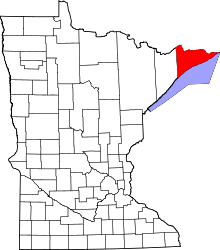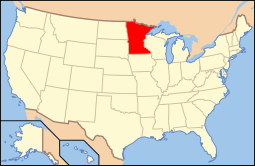Cook County, Minnesota
Not to be confused with Cook, Minnesota in Saint Louis County.
| Cook County, Minnesota | |
|---|---|
 Cook County Courthouse | |
 Location in the U.S. state of Minnesota | |
 Minnesota's location in the U.S. | |
| Founded | March 9, 1874[1] |
| Named for | Michael Cook, Territorial and State Senator[2] |
| Seat | Grand Marais |
| Largest city | Grand Marais |
| Area | |
| • Total | 3,340 sq mi (8,651 km2) |
| • Land | 1,452 sq mi (3,761 km2) |
| • Water | 1,887 sq mi (4,887 km2), 57% |
| Population (est.) | |
| • (2015) | 5,194 |
| • Density | 3.6/sq mi (1/km²) |
| Congressional district | 8th |
| Time zone | Central: UTC-6/-5 |
| Website |
www |
Cook County is a county located in the U.S. state of Minnesota. As of the 2010 census, the population was 5,176,[3] making it the fifth-least populous county in Minnesota. Its county seat is Grand Marais.[4] The Grand Portage Indian Reservation is entirely within the county.
History
The first inhabitants of what is now Cook County, Minnesota were the Ojibwe people.
The first non-Native Americans to ever set foot in what is now Cook County, Minnesota were French fur traders. Few of them remained permanently as year-round residents of the area and by the 1830s the French population of what is now Cook County numbered less than fifty.
In the 1830s migrants from New England began moving to what is now Minnesota. These were “Yankee” settlers, that is to say they were descended from the English Puritans who settled New England during the colonial era. While most of them came to Minnesota directly from New England, there were many who came from upstate New York. These were people whose parents had moved from New England to upstate New York in the immediate aftermath of the American Revolution. Due to the prevalence of New Englanders and New England transplants from upstate New York, Minnesota was very culturally contiguous with early New England culture for much of its early history.
The Yankee migration to Minnesota was a result of several factors, one of which was the overpopulation of New England. The old stock Yankee population had large families, often bearing up to ten children in one household. Most people were expected to have their own piece of land to farm, and due to the massive and nonstop population boom, land in New England became scarce as every son claimed his own farmstead. As a result there was not enough land for every family to have a self-sustaining farm, and Yankee settlers began leaving New England for the Midwestern United States.
They were aided in this effort by the construction and completion of the Erie Canal which made traveling to the region much easier, causing an additional surge in migrants coming from New England. Added to this was the end of the Black Hawk War, which made the region much safer to travel through and settle in for white settlers.
In the case of Cook County, most of its New England settlers came from Orange County, Vermont and the region of Down East Maine (modern day Washington County and Hancock County). Most of these settlers were fishermen and farmers. By 1845 there were roughly 350 people of European descent in what is now Cook County, virtually all from New England. By the time the county was founded in 1874, this number had risen to about 2,000.
These settlers were primarily members of the Congregational Church, though due to the Second Great Awakening, many of them had converted to Methodism, and some had become Baptists before coming to what is now Cook County. The Congregational Church has subsequently gone through many divisions, and some factions, including those in Cook County, are now known as the Church of Christ and the United Church of Christ.
When the New Englanders arrived, there was nothing but dense virgin forest and wild prairie. They laid out farms, constructed roads, erected government buildings and established post routes. Their presence led immediately to the establishment of a thriving fishing community, much like those they had left behind in Maine.
Though they were prosperous, there was also shortages of land. For most of the nineteenth century the majority of men born in what is now Cook County would end up leaving the area during their early adulthood to settle permanently elsewhere. By 1900 there were roughly 3,000 people in Cook County, despite many more people having been born there.
Between 1901 and 1905 European immigrants began to arrive in large numbers. They mostly came from Germany and Scandinavia, though some also came from Ireland (immigrants from these places arrived in southern Minnesota in earlier decades). They introduced Lutheranism and Catholicism to Cook County.
Geography

According to the U.S. Census Bureau, the county has a total area of 3,340 square miles (8,700 km2), of which 1,452 square miles (3,760 km2) is land and 1,887 square miles (4,890 km2) (57%) is water.[5] It is the second-largest county in Minnesota by total area. The highest natural point in Minnesota, Eagle Mountain at 2,301 feet (701 m), and the highest lake in Minnesota, Lake Abita at 2,048 feet (624 m), are both located in Cook County. Lake Superior is at the county's southern border.There is only one traffic light in the county.
Major highways
-
 Minnesota State Highway 61
Minnesota State Highway 61 -
 Cook County Road 12 – Gunflint Trail
Cook County Road 12 – Gunflint Trail
Adjacent counties
Cook County is in the extreme northeast of the state at the tip of the Arrowhead region; it is adjacent to only one other county by land. Its geographic neighbors are:
- Rainy River District, Ontario Canada (northwest)
- Thunder Bay District, Ontario Canada (northeast/EST Border east of the 90th meridian west)
- Lake County, Minnesota (west)
- Ashland County, Wisconsin (south)
- Keweenaw County, Michigan (east/EST Border)
- Ontonagon County, Michigan (southeast/EST Border)
National protected areas
- Grand Portage National Monument
- Superior National Forest (eastern part)
- Boundary Waters Canoe Area Wilderness (eastern part)
Climate
| Climate data for Lutsen, Minnesota | |||||||||||||
|---|---|---|---|---|---|---|---|---|---|---|---|---|---|
| Month | Jan | Feb | Mar | Apr | May | Jun | Jul | Aug | Sep | Oct | Nov | Dec | Year |
| Average high °F (°C) | 22 (−6) |
26 (−3) |
35 (2) |
47 (8) |
56 (13) |
64 (18) |
70 (21) |
70 (21) |
62 (17) |
52 (11) |
39 (4) |
27 (−3) |
47.5 (8.6) |
| Average low °F (°C) | 4 (−16) |
7 (−14) |
19 (−7) |
31 (−1) |
39 (4) |
45 (7) |
52 (11) |
54 (12) |
47 (8) |
38 (3) |
26 (−3) |
11 (−12) |
31.1 (−0.7) |
| Average rainfall inches (mm) | 0.9 (23) |
0.7 (18) |
1.4 (36) |
1.9 (48) |
2.8 (71) |
3.5 (89) |
3.3 (84) |
3.3 (84) |
3.6 (91) |
2.5 (64) |
1.6 (41) |
1.1 (28) |
26.4 (671) |
| Average snowfall inches (cm) | 15.2 (38.6) |
8.1 (20.6) |
8.1 (20.6) |
2.2 (5.6) |
0.2 (0.5) |
0 (0) |
0 (0) |
0 (0) |
0 (0) |
0.4 (1) |
3.8 (9.7) |
13.3 (33.8) |
50.8 (129) |
| Source: Weatherbase[6] | |||||||||||||
Northern Minnesota offers extreme winter weather. While the averages are low, the extremes provide more details. A third of the year is below freezing (31.9%, 116 days, or 4 months). Of those days, 21 are below zero degrees Fahrenheit (−17 °C).
| Jan | Feb | Mar | Apr | May | June | Jul | Aug | Sep | Oct | Nov | Dec | Year |
|---|---|---|---|---|---|---|---|---|---|---|---|---|
| Days Below 32 °F/0 °C[6] | ||||||||||||
| 20 | 18 | 19 | 13 | 3.5 | 0.1 | 0.1 | 0.0 | 0.5 | 5.8 | 16 | 20 | 116 |
| Days Below 0 °F/-17 °C[6] | ||||||||||||
| 8.2 | 6 | 1.5 | 0 | 0 | 0 | 0 | 0 | 0 | 5 | 0.5 | 4.8 | 21 |
Demographics
| Historical population | |||
|---|---|---|---|
| Census | Pop. | %± | |
| 1880 | 65 | — | |
| 1890 | 98 | 50.8% | |
| 1900 | 810 | 726.5% | |
| 1910 | 1,336 | 64.9% | |
| 1920 | 1,841 | 37.8% | |
| 1930 | 2,435 | 32.3% | |
| 1940 | 3,030 | 24.4% | |
| 1950 | 2,900 | −4.3% | |
| 1960 | 3,377 | 16.4% | |
| 1970 | 3,423 | 1.4% | |
| 1980 | 4,092 | 19.5% | |
| 1990 | 3,868 | −5.5% | |
| 2000 | 5,168 | 33.6% | |
| 2010 | 5,176 | 0.2% | |
| Est. 2015 | 5,194 | [7] | 0.3% |
| U.S. Decennial Census[8] 1790-1960[9] 1900-1990[10] 1990-2000[11] 2010-2015[3] | |||

As of the census of 2000,[12] there were 5,168 people, 2,350 households, and 1,438 families residing in the county. The population density was 4 people per square mile (1/km²). There were 4,708 housing units at an average density of 3 per square mile (1/km²). The racial makeup of the county was 89.45% White, 7.59% Native American, 0.33% Asian, 0.29% Black or African American, 0.04% Pacific Islander, 0.25% from other races, and 2.05% from two or more races. 0.75% of the population were Hispanic or Latino of any race. 21.6% were of German, 17.7% Norwegian, 11.5% Swedish, 7.2% Irish and 5.4% English ancestry.
There were 2,350 households out of which 24.40% had children under the age of 18 living with them, 52.00% were married couples living together, 6.10% had a female householder with no husband present, and 38.80% were non-families. 32.50% of all households were made up of individuals and 10.80% had someone living alone who was 65 years of age or older. The average household size was 2.17 and the average family size was 2.73.
In the county the population was spread out with 20.40% under the age of 18, 5.40% from 18 to 24, 25.80% from 25 to 44, 31.20% from 45 to 64, and 17.20% who were 65 years of age or older. The median age was 44 years. For every 100 females there were 99.70 males. For every 100 females age 18 and over, there were 98.50 males.
The median income for a household in the county was $36,640, and the median income for a family was $47,132. Males had a median income of $31,211 versus $23,650 for females. The per capita income for the county was $21,775. About 8.10% of families and 10.10% of the population were below the poverty line, including 12.20% of those under age 18 and 6.80% of those age 65 or over.
Communities
City
- Grand Marais (county seat)
Townships
Unincorporated communities
Unorganized territories
Ghost towns
See also
References
- ↑ "Minnesota Place Names". Minnesota Historical Society. Retrieved March 17, 2014.
- ↑ Upham, Warren (1920). Minnesota Geographic Names: Their Origin and Historic Significance. Minnesota Historical Society. p. 135.
- 1 2 "State & County QuickFacts". United States Census Bureau. Retrieved August 31, 2013.
- ↑ "Find a County". National Association of Counties. Archived from the original on 2011-05-31. Retrieved 2011-06-07.
- ↑ "2010 Census Gazetteer Files". United States Census Bureau. August 22, 2012. Archived from the original on October 6, 2014. Retrieved October 6, 2014.
- 1 2 3 "Weatherbase: Historical Weather for Lutsen, Minnesota". Retrieved January 9, 2009.
- ↑ "County Totals Dataset: Population, Population Change and Estimated Components of Population Change: April 1, 2010 to July 1, 2015". Retrieved July 2, 2016.
- ↑ "U.S. Decennial Census". United States Census Bureau. Archived from the original on May 11, 2015. Retrieved October 6, 2014.
- ↑ "Historical Census Browser". University of Virginia Library. Retrieved October 6, 2014.
- ↑ "Population of Counties by Decennial Census: 1900 to 1990". United States Census Bureau. Retrieved October 6, 2014.
- ↑ "Census 2000 PHC-T-4. Ranking Tables for Counties: 1990 and 2000" (PDF). United States Census Bureau. Retrieved October 6, 2014.
- ↑ "American FactFinder". United States Census Bureau. Archived from the original on 2013-09-11. Retrieved 2008-01-31.
External links
- Cook County Government's website
- Mn/DOT – maps of Cook County (Southwest portion, Eastern portion, Northwest portion)
 |
Thunder Bay District, Ontario, Canada | Thunder Bay District, Ontario, Canada |  | |
| Lake County | |
Keweenaw County, Michigan | ||
| ||||
| | ||||
| Lake Superior | Ontonagon County, Michigan |
Coordinates: 47°55′N 90°33′W / 47.917°N 90.550°W